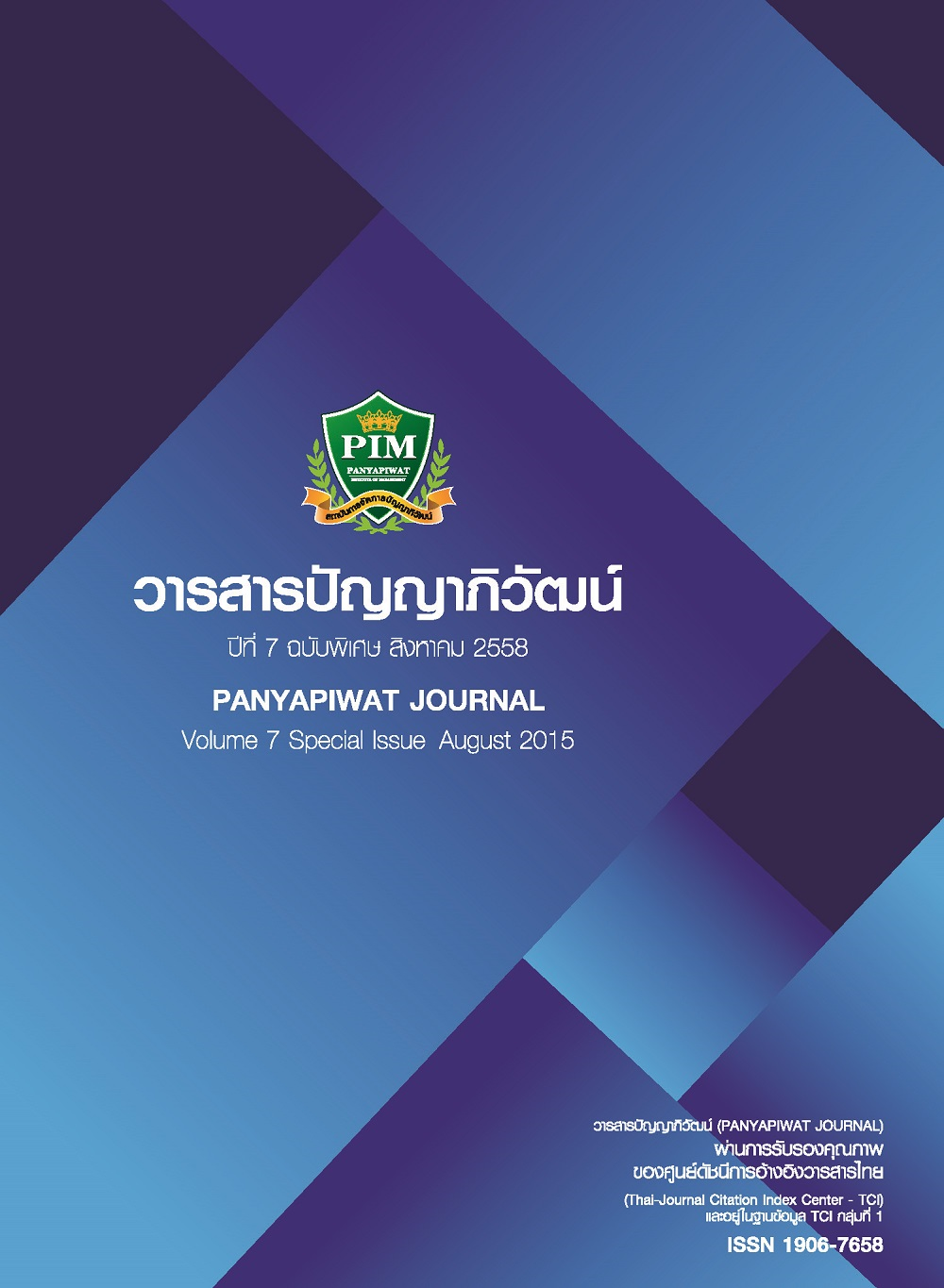MARKET OPPORTUNITY FOR LAUNCHING THE HYGIENIC HAND CREAM IN BANGKOK METROPOLITAN AREA
Main Article Content
บทคัดย่อ
This study aimed to investigate market opportunity for introducing the Hygienic Hand Cream in Thailand. There are numbers of hand hygiene products available in Thailand, however, most of them are alcohol-based products which occasionally caused several skin problems. This new product launch “Hygienic Hand Cream” could be a perfect product substitution and better diversification than alcohol-based hand gel. Thus the study attempted to discover consumers buying factors using demographic and marketing factors, which could consequently influence consumers’ decision making. Self-administered questionnaires had been launched in Bangkok metropolitan area using simple random sampling technique and tools of research. Through a basic descriptive statistics as well as logit and probit regression models, the results clearly show that consumers’ buying decisions depend on pricing as the most significant. Consumers who have already used alcohol-based hand gel will be willing to buy the new Hygienic Hand Cream compared to consumers who never used this kind of products previously.
การวิจัยนี้มีวัตถุประสงค์เพื่อสำรวจโอกาสสำหรับครีมทามืออนามัยในตลาดประเทศไทยโดยเฉพาะในเขตกรุงเทพมหานคร ซึ่งมีจำนวนของผลิตภัณฑ์ทำความสะอาดมือมากมาย อย่างไรก็ตามผลิตภัณฑ์ทำความสะอาดมือที่มีส่วนผสมของแอลกอฮอล์มักเป็นสาเหตุของการระคายเคืองผิว ครีมทามืออนามัยอาจเป็นทางเลือกที่ดีที่จะทดแทนผลิตภัณฑ์อนามัยที่มีส่วนผสมของแอลกอฮอล์ ดังนั้นการวิจัยนี้จะหาปัจจัยของการตัดสินใจซื้อของผู้บริโภค โดยแจกแบบสอบถามในกรุงเทพฯ จากการสำรวจพบว่า การตัดสินใจซื้อของผู้บริโภคขึ้นอยู่กับปัจจัยด้านราคามากที่สุด และผู้บริโภคที่ใช้เจลทามืออนามัยมีความปรารถนาที่จะทดลองใช้ครีมทามืออนามัยมากกว่าผู้ที่ไม่เคยใช้
Article Details
“ข้าพเจ้าและผู้เขียนร่วม (ถ้ามี) ขอรับรองว่า บทความที่เสนอมานี้ยังไม่เคยได้รับการตีพิมพ์และไม่ได้อยู่ระหว่างกระบวนการพิจารณาลงตีพิมพ์ในวารสารหรือแหล่งเผยแพร่อื่นใด ข้าพเจ้าและผู้เขียนร่วมยอมรับหลักเกณฑ์การพิจารณาต้นฉบับ ทั้งยินยอมให้กองบรรณาธิการมีสิทธิ์พิจารณาและตรวจแก้ต้นฉบับได้ตามที่เห็นสมควร พร้อมนี้ขอมอบลิขสิทธิ์บทความที่ได้รับการตีพิมพ์ให้แก่สถาบันการจัดการปัญญาภิวัฒน์หากมีการฟ้องร้องเรื่องการละเมิดลิขสิทธิ์เกี่ยวกับภาพ กราฟ ข้อความส่วนใดส่วนหนึ่งและ/หรือข้อคิดเห็นที่ปรากฏในบทความข้าพเจ้าและผู้เขียนร่วมยินยอมรับผิดชอบแต่เพียงฝ่ายเดียว”
เอกสารอ้างอิง
Anderson, J. L., Warren, C. A., Perez, E., Louis, R. I., Phillips, S., Wheeler, J., Cole, M. & Misra, R. (2008). Gender and ethnic differences in handhygiene practices among collegestudents. JAIC, 36(5), 361-368.
Angelis, A. (2013). The Future Of the Skincare Market in Thailand to 2017. Retrieved April 15, 2015, from http://www.cosmeticsdesign-asia.com/Market-Trends/Growing-market-for-Thai-skin-care-predicted
Bodimeade, M. (2013). The Future of the Skincare Market in Thailand to 2017. Retrieved April 15, 2015, from http://www.companiesandmarkets.com/Market/Healthcare-and-Medical/Market-Research/The-Future-of-the-Skincare-Market-in-Thailand-to-2017/RPT1168638
Chitsamphandhvej, W., Teewasutornkun, P. & Banditwongpisarn, A. (2008). CHLOROFORM RESULTED FROM TRICLOSAN IN TOOTHPASTE. Department of Chemistry, Faculty of Science, King Mongkut’s University.
Haas, C. N., Marie, J. R., Rose, J. B. & Gerba, C. P. (2004). Assessment of benefits from use of antimicrobial hand products: Reduction in risk from handling ground beef. Department of Civil, Architectural and Environmental Engineering, Drexel University, Philadelphia PA 19104, USA, Carollo Engineers, Phoenix AZ, USA, Department of Fisheries and Wildlife, Michigan State University, East Lansing MI, USA, Department of Soil, Water and Environ-mental Science, University of Arizona, Tucson AZ, USA, January 2004.
Haas, P. J. & Larson, E. L. (2008). Compliance with Hand Hygiene. AJN, 108(8), 40-44.
Hilburn, J., Hammond, B. S., Fendler, E. J. & Groziak, P. A. (2003). Use of alcohol hand sanitizer as an infection control strategy in an acute care facility. AJIC, 31(2). 109-116.
Kampf, G. & Löffler, H. (2003). Dermatological aspects of a successful introduction and continuation of alcohol-based hand rubs for hygienic hand disinfection. Journal of Hospital Infection, 55(1), 1-7.
Kampf, G. & Ennen, J. (2006).Regular use of a hand cream can attenuate skin dryness and roughness caused by frequent hand washing. BMC Dermatology, 6(1).
Kasempipatkun, P. (2014). Factors related and affected repurchase intention of pharmaceutical products manufactured in Thailand by hospitals and clinics. Bangkok University.
Komonruginan, U. (2015). PR Chula, 2015. Retrieved April 15, 2015, from http://www.pr.chula.ac.th/index.php/15-article/124-2014-10-27-07-28-13
Kotler, P. (2000). Marketing management. University of Michigan, Prentice Hall international. US.
Larson, E., Girard, R., Pessoa-Silva, C. L., Boyce, J., Donaldson, L. & Pittet, D. (2006). Skin reactions related to hand hygiene and selection of hand hygiene products. AJIC, 34(10), 627-635.
Mitpratan, N. (2011). Factors affecting purchasing behaviors of sun protection body lotion among consumers in Bangkok. Srinakharinwirot University.
Onanong, S. & Kongswatkiert, K. (2011). Marketing factors influencing buying cosmetics of students in universities located Pathumthani. Journal of finance investment marketing and business administration, 1(3), 23-38.
Songserm, T., Jam-on, R., Sae-Heng, N., Memak, N., Hulse-Post, D. J., Sturm-Ramirez, K. M. & Webster, R. G. (2006). Domestic ducks and H5N1 influenza epidemic, Thailand. Emerging Infectious Diseases. Emerging Infectious Diseasea, 12(4), 575-581.
Sameer, K. (2004). Exploratory analysis of global cosmetic industry: major players, technology and market trends. College of Business, University of St Thomas, USA, 7 August 2004.
Thailand cosmetic society. (2014). Cosmetic market in Thailand. Retrieved June 8, 2015, from http://www.krobkruakao.com/%E0%B8%82%E0%B9%88%E0%B8%B2%E0%B8%A7%E0%B9%80%E0%B8%A8%E0%B8%A3%E0%B8%A9%E0%B8%90%E0%B8%81%E0%B8%B4%E0%B8%88/109629/%E0%B8%95%E0%B8%A5%E0%B8%B2%E0%B8%94%E0%B9%80%E0%B8%84%E0%B8%A3%E0%B8%B7%E0%B9%88%E0%B8%AD%E0%B8%87%E0%B8%AA%E0%B8%B3%E0%B8%AD%E0%B8%B2%E0%B8%87%E0%B9%82%E0%B8%95%E0%B8%AA%E0%B8%A7%E0%B8%99%E0%B8%81%E0%B8%A3%E0%B8%B0%E0%B9%81%E0%B8%AA%E0%B9%80%E0%B8%A8%E0%B8%A3%E0%B8%A9%E0%B8%90%E0%B8%81%E0%B8%B4%E0%B8%88.html
Usanit, Y. (2011). Factors affecting the decision to purchase herbal facial skin One Tambon One Product of consumer in Bangkok province. Bangkok: RMUTT Research Repository.


